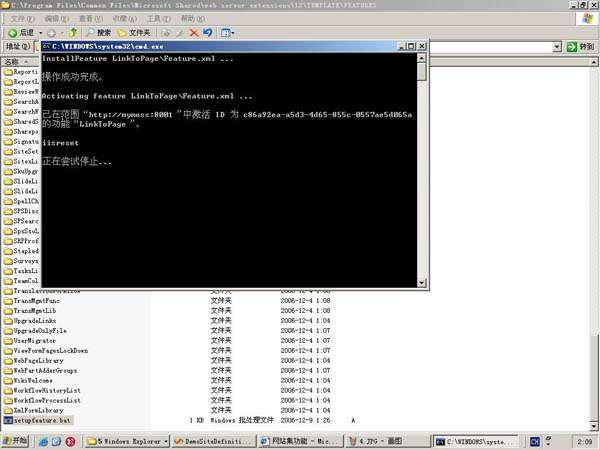MOSS 2007入门(5) : 使用Feature定义站点中的菜单项
2006-12-09 02:38
453 查看
前面的文章提到了:Everything is feature.今天就来讲讲feature的使用.在MOSS 2007中feature功能之强大超乎想象,可以说对一个已有的网站功能性的增强最后多数都要通过feature来实现.例如添加webpart,实现Event Handler等等...今天就做一个使用feature定义网站中的菜单项的Demo.
Step(1):在网站中创建一个页面,存放于一个文档库中,这里我创建的页面在文档库SiteCollectionDocuments下testpage.aspx,那么这个页面的引用路径就是<%siteurl%>/SiteCollectionDocuments/testpage.aspx .
<?xml version="1.0" encoding="utf-8" ?>
<Feature Id="C86A92EA-A5D3-4d65-855C-0557AE5D065A"
Title="Link To Page"
Description="This example show how to create a menu linke to a customize page!"
Version="1.0.0.0"
Scope="Site"
AlwaysForceInstall="TRUE"
xmlns="http://schemas.microsoft.com/sharepoint/">
<ElementManifests>
<ElementManifest Location="LinkToPage.xml" />
</ElementManifests>
</Feature>
Feature元素的几个属性说明一下:
Id:这里要使用vs的guid工具生成一个guid,copy过来就可以
Title 和 Description分别是Feature的标题和描述.
Scope这个属性比较重要:是一个枚举值,是用来描述这个feature的作用范围.这里选择:site
AlwaysForceInstall:这个属性设置为true 可以在重复安装这个feature中自动覆盖原来安装的那个相同的feature.
ElementManifest的location属性制定一个描述feature内容的xml文件,这里叫做LinkToPage.xml
Step(3):建立上一步中的LinkToPage.xml,内容如下.
<?xml version="1.0" encoding="utf-8" ?>
<Elements xmlns="http://schemas.microsoft.com/sharepoint/">
<CustomAction Id="LinkToPageInactionsMenu"
RegistrationType="List"
RegistrationId="101"
GroupId="ActionsMenu"
Location="Microsoft.SharePoint.StandardMenu"
Sequence="1000"
Title="Link To Page"
Description="This is action menu"
>
<UrlAction Url="~sitecollection/SiteCollectionDocuments/testpage.aspx"/>
</CustomAction>
<CustomAction Id="LinkToPage"
RegistrationType="List"
RegistrationId="101"
GroupId="NewMenu"
Location="Microsoft.SharePoint.StandardMenu"
Sequence="1000"
Title="Link To Page"
Description="This is new menu!"
>
<UrlAction Url="~sitecollection/SiteCollectionDocuments/testpage.aspx"/>
</CustomAction>
</Elements>
这个xml文件中可以多个CustomAction来描述feature的实际内容,这里采用了两个。
Location和groupid两个属性分别指定该feature是定义了哪两个菜单.
Sequence属性指定新增加的菜单项在这个菜单中的排序,设置的大一点该菜单项排列就靠后.
Title 和 Description分别是该菜单项的标题和描述.
UrlAction属性指定了该菜单项的连接到的页面,当然了,这个demo连接到的是我们在第一步中建立那个页面.这里有一个相对路径的问题,~site 表示站点的主目录, ~sitecollection 表示站点集的主目录.因为我的demo是做在一个站点集下面的,所以采用~sitecollection后面是连接文件的相对路径..
Step(4):下面就是将这个feature部署到站点,因为可能会经常使用到部署feature这样的功能,那么我们写一个通用的bat文件来实现feature的部署,内容如下.
@rem======================================================================
@rem
@rem setupfeature.bat
@rem
@rem======================================================================
@echo off
setlocal
pushd .
goto InstallFeature
@rem----------------------------------------------------------------------
@rem InstallFeature
@rem----------------------------------------------------------------------
:InstallFeature
set SPAdminTool=%CommonProgramFiles%\Microsoft Shared\web server extensions\12\BIN\stsadm.exe
set TargetUrl=http://mymoss:8001
set FeaturePath=LinkToPage\Feature.xml
echo InstallFeature %FeaturePath%
"%SPAdminTool%" -o installfeature -filename %FeaturePath%
echo Activating feature %FeaturePath%
"%SPAdminTool%" -o activatefeature -filename %FeaturePath% -url %TargetUrl%
echo iisreset
iisreset
其中每次只要更改TargetUrl和FeaturePath就可以了,是不是方便了很多.
实际上看这个文件中的内容就知道,通过stsadm命令的-o instanllfeature安装这个feature,然后通过stsadm命令的-o activatefeature激活这个feature,然后iisreset一下.将这个bat文件放在12\TEMPLATE\FEATURES,双击执行就可以.

Step(5):进入站点新建一个文档库,看看文档库的菜单中是不是多出了两项?


到网站设置的网站集功能中看看,是不是有一个Link to Page的feature已经被激活.
Step(6): 通过列表的菜单我们可以链接到刚刚所建立的新页面,但是怎么能通过这个链接传递数据呢?也就是说可以在testpage.aspx中获取列表的Id. ok,将UrlAction更改为<UrlAction Url="~sitecollection/SiteCollectionDocuments/testpage.aspx?listid={ListId}"/> , 保存文件之后重新运行installfeature.bat,新建一个列表,重新使用该功能定位到testpage.aspx,看看是不是能在querystring中获得列表的guid了.
ok,以上就是使用feature来Feature定义站点中的菜单项的DEMO.
Enjoy it....
Step(1):在网站中创建一个页面,存放于一个文档库中,这里我创建的页面在文档库SiteCollectionDocuments下testpage.aspx,那么这个页面的引用路径就是<%siteurl%>/SiteCollectionDocuments/testpage.aspx .
<?xml version="1.0" encoding="utf-8" ?>
<Feature Id="C86A92EA-A5D3-4d65-855C-0557AE5D065A"
Title="Link To Page"
Description="This example show how to create a menu linke to a customize page!"
Version="1.0.0.0"
Scope="Site"
AlwaysForceInstall="TRUE"
xmlns="http://schemas.microsoft.com/sharepoint/">
<ElementManifests>
<ElementManifest Location="LinkToPage.xml" />
</ElementManifests>
</Feature>
Feature元素的几个属性说明一下:
Id:这里要使用vs的guid工具生成一个guid,copy过来就可以
Title 和 Description分别是Feature的标题和描述.
Scope这个属性比较重要:是一个枚举值,是用来描述这个feature的作用范围.这里选择:site
AlwaysForceInstall:这个属性设置为true 可以在重复安装这个feature中自动覆盖原来安装的那个相同的feature.
ElementManifest的location属性制定一个描述feature内容的xml文件,这里叫做LinkToPage.xml
Step(3):建立上一步中的LinkToPage.xml,内容如下.
<?xml version="1.0" encoding="utf-8" ?>
<Elements xmlns="http://schemas.microsoft.com/sharepoint/">
<CustomAction Id="LinkToPageInactionsMenu"
RegistrationType="List"
RegistrationId="101"
GroupId="ActionsMenu"
Location="Microsoft.SharePoint.StandardMenu"
Sequence="1000"
Title="Link To Page"
Description="This is action menu"
>
<UrlAction Url="~sitecollection/SiteCollectionDocuments/testpage.aspx"/>
</CustomAction>
<CustomAction Id="LinkToPage"
RegistrationType="List"
RegistrationId="101"
GroupId="NewMenu"
Location="Microsoft.SharePoint.StandardMenu"
Sequence="1000"
Title="Link To Page"
Description="This is new menu!"
>
<UrlAction Url="~sitecollection/SiteCollectionDocuments/testpage.aspx"/>
</CustomAction>
</Elements>
这个xml文件中可以多个CustomAction来描述feature的实际内容,这里采用了两个。
Location和groupid两个属性分别指定该feature是定义了哪两个菜单.
Sequence属性指定新增加的菜单项在这个菜单中的排序,设置的大一点该菜单项排列就靠后.
Title 和 Description分别是该菜单项的标题和描述.
UrlAction属性指定了该菜单项的连接到的页面,当然了,这个demo连接到的是我们在第一步中建立那个页面.这里有一个相对路径的问题,~site 表示站点的主目录, ~sitecollection 表示站点集的主目录.因为我的demo是做在一个站点集下面的,所以采用~sitecollection后面是连接文件的相对路径..
Step(4):下面就是将这个feature部署到站点,因为可能会经常使用到部署feature这样的功能,那么我们写一个通用的bat文件来实现feature的部署,内容如下.
@rem======================================================================
@rem
@rem setupfeature.bat
@rem
@rem======================================================================
@echo off
setlocal
pushd .
goto InstallFeature
@rem----------------------------------------------------------------------
@rem InstallFeature
@rem----------------------------------------------------------------------
:InstallFeature
set SPAdminTool=%CommonProgramFiles%\Microsoft Shared\web server extensions\12\BIN\stsadm.exe
set TargetUrl=http://mymoss:8001
set FeaturePath=LinkToPage\Feature.xml
echo InstallFeature %FeaturePath%
"%SPAdminTool%" -o installfeature -filename %FeaturePath%
echo Activating feature %FeaturePath%
"%SPAdminTool%" -o activatefeature -filename %FeaturePath% -url %TargetUrl%
echo iisreset
iisreset
其中每次只要更改TargetUrl和FeaturePath就可以了,是不是方便了很多.
实际上看这个文件中的内容就知道,通过stsadm命令的-o instanllfeature安装这个feature,然后通过stsadm命令的-o activatefeature激活这个feature,然后iisreset一下.将这个bat文件放在12\TEMPLATE\FEATURES,双击执行就可以.

Step(5):进入站点新建一个文档库,看看文档库的菜单中是不是多出了两项?


到网站设置的网站集功能中看看,是不是有一个Link to Page的feature已经被激活.
Step(6): 通过列表的菜单我们可以链接到刚刚所建立的新页面,但是怎么能通过这个链接传递数据呢?也就是说可以在testpage.aspx中获取列表的Id. ok,将UrlAction更改为<UrlAction Url="~sitecollection/SiteCollectionDocuments/testpage.aspx?listid={ListId}"/> , 保存文件之后重新运行installfeature.bat,新建一个列表,重新使用该功能定位到testpage.aspx,看看是不是能在querystring中获得列表的guid了.
ok,以上就是使用feature来Feature定义站点中的菜单项的DEMO.
Enjoy it....
相关文章推荐
- MOSS 2007 入门(4) : 站点定义和站点模板
- Feature 之使用Feature定义站点中的菜单项(另外可定义content type菜单项)
- MOSS 2007 入门 : 站点定义和站点模板
- 使用Feature 向MOSS站点注册页面
- 如何在MOSS 2007 中将一个Document Library 增加到站点定义中
- MOSS 2007 入门(6) : 使用一个Code-behind的用户控件作为WebPart
- MOSS 2007 入门(2) 定制站点的CSS文件
- MOSS 2007中如何使用三态工作流
- MOSS 2007 应用随笔(17)-- 使用SPEventHandler事件处理程序(一)启用事件处理机制
- javascript入门系列演示·函数的定义以及简单参数使用,调用函数
- Moss 2007中访问群体的设置和使用
- Moss 2007 BDC使用记录
- 在MOSS 2007中使用Web Capture这个WebPart
- PHP入门-函数的定义与使用
- ASP.NET2.0 快速入门 ----使用主题对站点进行自定义
- 7天入门php-session基础使用及预定义常量
- MOSS 2007 入门(3) : 建立一个最精简的母版页
- Json入门--基础定义及使用
- HTML5之SVG 2D入门10―滤镜的定义及使用
- MOSS 2007应用--如何使用文档转换
